Over 90% of Koi ponds around the world use what I term to be ‘upward-flow boxes’ on the biological stages of their filtration systems.
My term of ‘upward-flow’ relates to single units, multi-chamber units, vortex units, pressurised units either fed water by gravity or fed water by pump.
I first witnessed these open multi-chamber units being used by the Japanese breeders in 1977 and decided that if they were good enough for them – then they were good enough for all of us.
In 1979 I produced my first ready-made filters and in 1981 produced the first multi-bay units, which have since been copied by other manufacturers and are still offered for sale today and still bought by Koi enthusiasts today.
All of these were upward-flow units.
I honestly believed for many years that upward-flow water was the only real way to filter a Koi pond but it wasn’t until 2008 that I started to seriously question my own beliefs.
This is not an attempt to belittle these units but it is an attempt to explain to others exactly just how inefficient they actually are in providing good biological filtration to any fishpond.
As a reminder here, near-perfect biological filtration depends on the fact that ALL the ammonia-rich water entering the box from the pond actually comes into contact with ALL the media surfaces before it ALL exits the box and returns to the pond to make way for more ammonia-rich water to enter the box.
In short, ALL the media surfaces should be supplied with a constant flow of water at ALL times.
On paper this sounds to be fairly easy to achieve – but in practise this is not nearly the case.
In fact, if the truth is known, it’s absolutely IMPOSSIBLE to achieve this in an upward-flow situation.
Take this standard multi-bay chamber complete with tailored Japanese filter mat cartridges as an example –
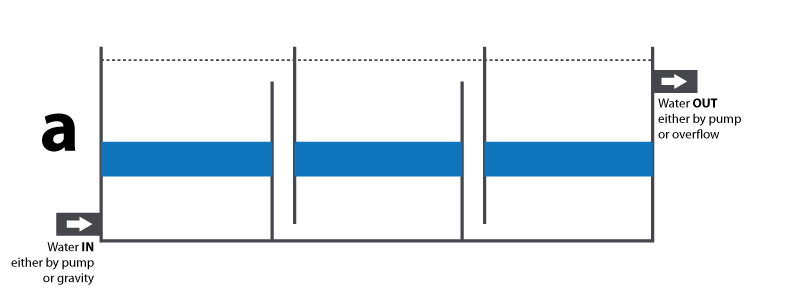
As the pond water enters the first box by gravity it rises through the media block perfectly because water HAS to rise at an equal level so this can be termed as perfect biological filtration. All media surfaces are being supplied with the same amount of water at exactly the same flow rate.
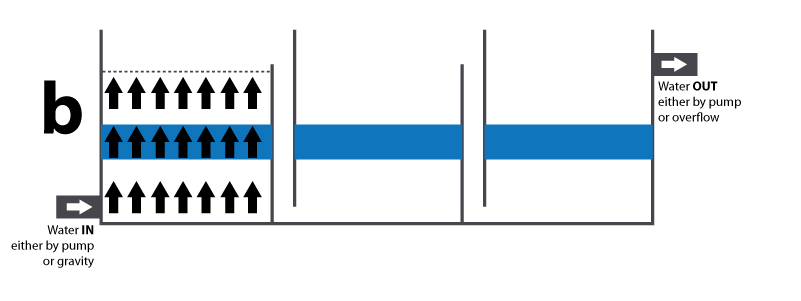
However once the surface water in the first chamber falls down the transfer port and then into the second chamber, everything changes in the first chamber, which now looks like this –
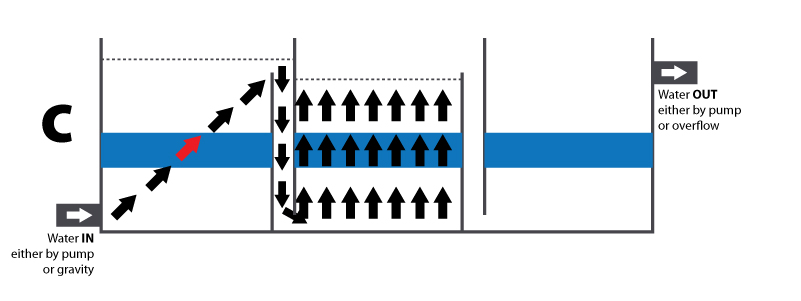
The red arrow shown on this illustration (C) is the only part of the media that’s being supplied by the incoming water.
Now the second chamber begins to fill perfectly until that too reaches the transfer port.
As soon as it starts to fall down the transfer port into the last chamber everything also changes in the second chamber, which now looks something like this –
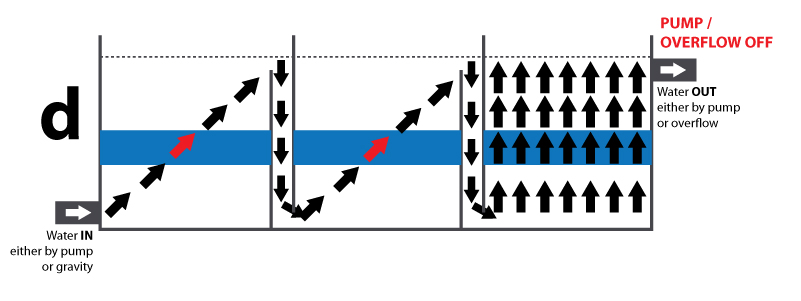
Water now enters the third chamber and rises perfectly until the pump or overflow that will return the water back to the pond picks it up. And once the pump is switched on or water exits the overflow everything also changes in the third chamber, which now looks something like this –
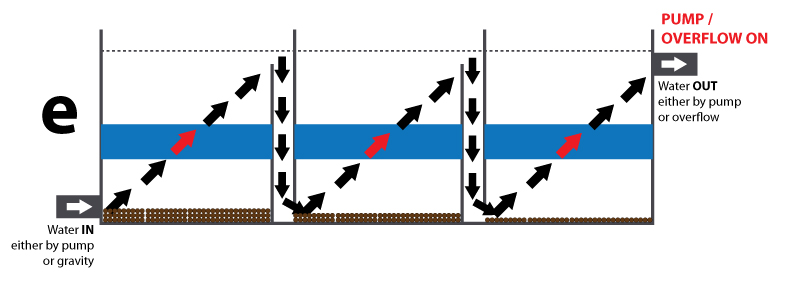
The red arrows show the amount of media actually coming into contact with the water that’s actually passing through the box.
In short, because of the ‘tracking’ that must take place, less than 15% of the media inside these boxes get no new water supply at all!
In truth, the vast majority of water in the boxes has been there since the day they were first filled!
Furthermore 85% of the water used to fill the boxes will remain in the boxes until the entire box is drained to waste.
Please also note the debris that’s forming in the bases of these boxes day after day.
Of course this is all hidden from view by the media in the boxes but it does continue to be deposited on to the bases of the boxes with each passing day.
The main reason why most ponds using these filter units suffer with endless bacterial problems with their Koi is because of the amount of decaying matter hidden below the media which all plays a part in polluting the pond water.
Here is a simplified version using a single chamber upward-flow box, on first fill only the incoming water covers all media surfaces perfectly –
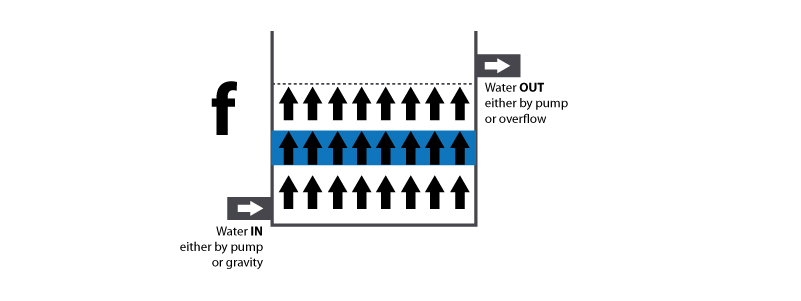
And here’s what happens again when the pump or overflow is applied –
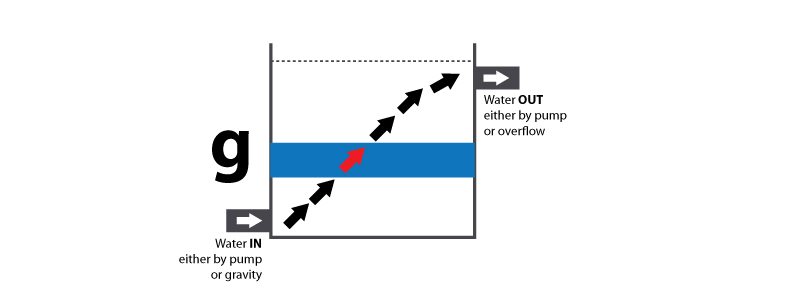
There’s only one way to get the perfect upward-flow situation to continue and that’s by getting the pump or overflow to remove the entire top surface water instantly like this –
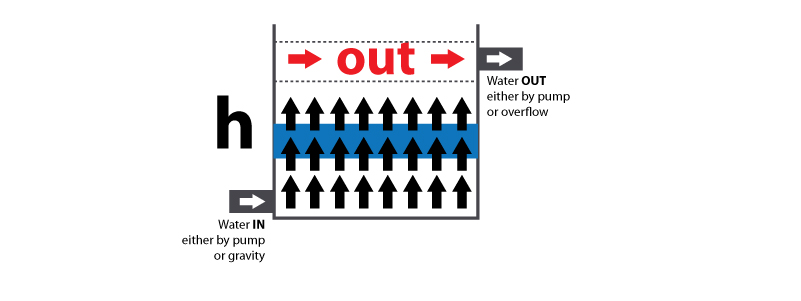
If this ‘could’ be done then water would continue to rise perfectly as in illustration ‘H’.
Unfortunately, there is no pump or overflow in the world capable of removing an entire block of surface water. Instead the water removed is the water nearest to the pump inlet or the overflow and thus the tracking continues.
Coming back to the original multi-chamber box above, this would work MUCH better if it were filtered like this –
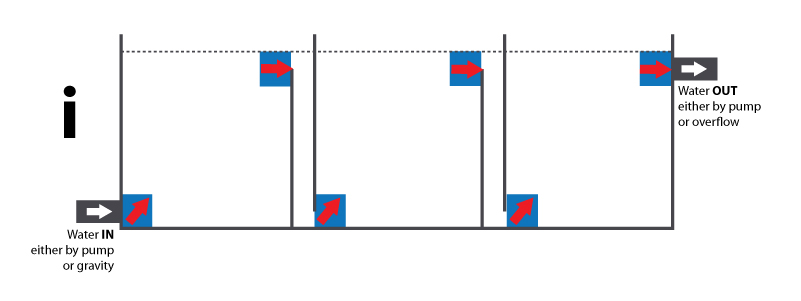
At least all the water tracking through the box would come into contact with all the media surfaces before it exits the box.
Debris would still be seen to settle on the bases, but because it could be seen it could also be siphoned away thus reducing potential bacterial problems with the Koi.
Just about everyone using these upward-flow boxes are warned in advance to expect ‘New Pond Syndrome’ (NPS) – when starting these boxes up for the first time.
They are told it’s an unavoidable period that’s required to produce stable water conditions by maturing the filter.
During this time pH, nitrite and ammonia readings will fluctuate constantly then feeding has to be reduced, more water changes have to be made and the whole nightmare can take months before standard water tests confirm ‘stability’.
This is not the case at all, the reason for all these problems is simply because so little of the media surfaces are coming into contact with the water passing through the box and even when the box is said to be stable, it’s only ‘just’ stable.
Any excess feeding and dosages of standard anti-parasite medication can easily take the system right back to day one.
Up to now I’ve only shown static media illustrations but there are many upward-flow units using moving media such as semi-buoyant plastic that is moved by aeration and this producing the illusion that everything is ‘happening’ within the box.
The truth is, that this type of media is even less efficient than the static media.
At least with the static media some parts are being used constantly at a given flow rate and dwell time whilst the few moving plastic parts that actually come into contact with the water flow have hardly any dwell time at all before they are moved out of the water flow and this is not nearly long enough to produce bacterial stability on the surfaces.
Coming back to the Japanese breeders who use these upward-flow boxes on their indoor systems where their stocks are kept from October until early June.
The very moment their stocks are placed in the field ponds in early June, their indoor systems are drained, all the media in the filter boxes is removed and pressure-washed, the pond and the filter boxes are scrubbed thoroughly and are then allowed to dry for the rest of the summer.
In early October they are filled with mains water and started up again as brand new ponds every single year.
Our ponds need to be run constantly – year in and year out.
If you consider your filter system to be the pond lavatory (which it is) and then consider that the very moment you start it up it’s in the ‘engaged’ position permanently (which it is) and then consider it’s in a constant state of deterioration (which it is) – then compare it to your domestic lavatory that’s probably ‘engaged’ for only one hour per day – just how many days would you leave your own domestic lavatory before flushing?
Pond filter systems are only boxes where unwanted debris is collected and trapped before it’s all flushed to waste and the filter box can then be started up again as brand new.
Once again, upward-flow boxes are not only very inefficient they are also potentially very dangerous and are the main reasons why so many collections of Koi suffer with these constant bacterial disorders.
It’s also the reason why we see many instances of shimi and hikui forming in these systems.
In 1991 I came up with another way of addressing this problem and I really believed I was onto something big!
I used my standard vortex unit as a prime mechanical stage and linked to it three identical-sized units containing filter mat cartridges as the biological stages.
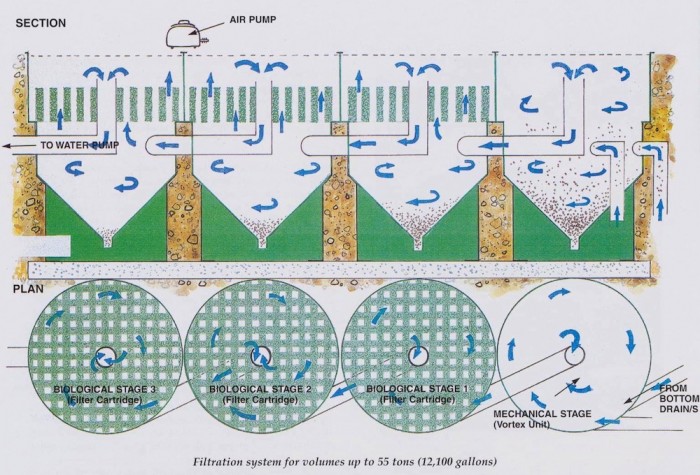
Water entered the prime stage via a 4” line from the drain on a tangent in order to start the spin and exited centrally at the top of the chamber into a 6” tube that took the water on a tangent to the next stage.
All units had a 3” bore ball valve that removed all the waste perfectly from the bottom of the cone.
I thought my circular ‘upward-flow’ design had finally cracked it!
Alas, that was not the case and you only needed your eyes to see why it was not the case.
After around one month of running, the majority of the filter mat cartridge carried a fine brown dust on the top of it and only a 2.5” circle around the 6” outlet remained blue.
The water passing through these units was simply tracking to the 6” outlet and only that very small area of the cartridge was biologically active.
The vast majority of water in the box surrounding that part of the cartridge was simply standing there and had been standing there since the unit was first filled.
The only ways of removing the dust was by siphon or by draining the entire unit and brushing it away with a hosepipe.
By far, the most dangerous of upward-flow units being used today are known as bead filters. These are totally enclosed pressurised units that use small plastic beads as a filter media.
Although no-one can actually see what’s going on inside them, we are told that the beads inside the unit trap all the debris and the backwash facility takes all the debris to waste.
Here’s a shot of one of these units that has been installed on a Koi pond and has been running for some time.

This particular unit was thoroughly backwashed twice a day, which also resulted in a huge loss of pond water every day.
Immediately after one of these backwashes, the top was removed and this is what was found.



Now can you imagine what would be found at the base of the unit?
Incidentally the pumps required to power these units are pressure pumps and running costs are high.
If this article has been of benefit to ANY reader out there, then it’s served its purpose!
Peter Waddington, September 2012.
